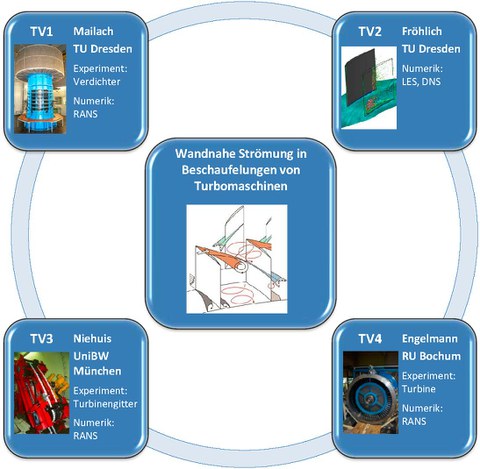Wandnahe periodisch instationäre Strömung im rotierenden Verdichtergitter
Periodic unsteady flow near the endwall in rotating annular compressor cascades
| Project leader: | Prof. Dr.-Ing. habil. Ronald Mailach |
| Project Member: | Dipl.-Ing. Björn Koppe |
| Financing: | DFG |
|
Term: |
02/2018 – 06/2021 |
| Term of Extension: | 04/2022 – 06/2024 |
| Funding Code: | MA 4922/8-1 |
|
Funding Code of Extension: |
MA 4922/11-1 |
The steady development of economic and efficient aero engines leads to increased aerodynamic loading of blade rows and the intensification of loss generating secondary flows. The latter being predominant in the endwall region of the cascade and a focus of research for years.
The interacting unsteady secondary flow effects will be analyzed within the DFG research project PAK 948 “Flow near the endwall of turbomachinery blading” in cooperation with the UniBW Munich and the RU Bochum. Therefor experiments at the low speed research compressor (LSRC) are conducted at the Chair of Turbomachinery and Flight Propulsion, where the flow regions near the endwall are of specific interest as well as their comparison to the same regions in a linear cascade. Distinct stepwise abstractions using appropriate test assemblies at the LRSC with stationary annular cascades (stator) with and without radial clearance to the rotating / non-rotating hub endwall and rotating annular cascades (rotor) with and without wake generators for the simulation of rotor-stator-interaction are used for the latter. This allows the evaluation of the effects of rotation, Coriolis- and centrifugal accelerations, increasing pitch with blade height, radial pressure gradients, relative motion of the endwalls and shear of the inlet boundary layer separately. All test assemblies and further parameter variations will additionally be analyzed through Computational Fluid Dynamics (RANS/URANS-methods).
Within the extension period supplementary studies on the Rotor-Stator-Interaction are conducted, where a locally high-resolution measuring technique will allow to characterize the flow within the radial gap of the rotor in more detail. Additionally, a parametric variation of the incoming wakes will increase the understanding of the influence of this effect on the secondary flow system of a compressor rotor. Here, other operating points next to the design point, which was the focus of the first funding period, will also be considered.
Partner:
TU Dresden, Professur für Strömungsmechanik
UniBW München, Institut für Strahlantriebe
Ruhr-Universität Bochum, Lehrstuhl für Thermische Turbomaschinen und Flugtriebwerke

